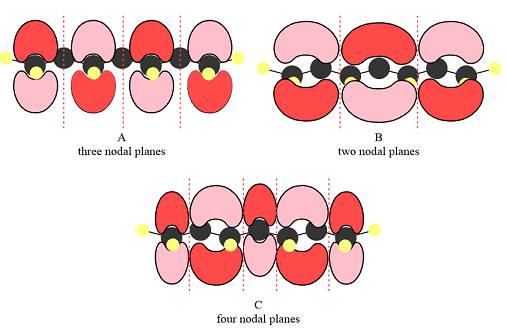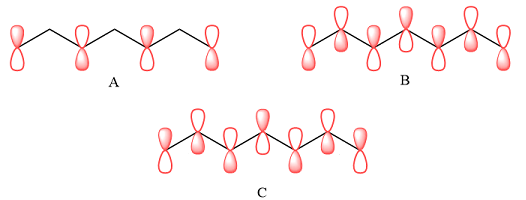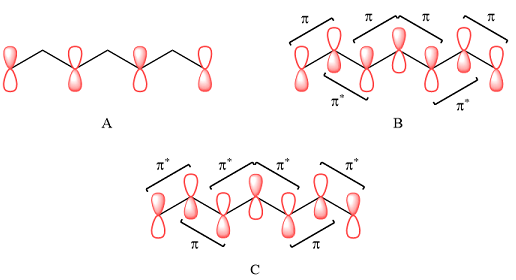
(a)
Interpretation:
The number of nodal planes perpendicular to the bonding axes of each of the three
Concept introduction:
Overlap of atomic orbitals (AOs) can be thought of as wave interference. It can be constructive or destructive. Constructive interference increases the electron density between two nuclei (an antinode) and results in a molecular orbital (MO) of lower energy. The phases of overlapping orbitals are the same in this case. Destructive interference decreases the electron density between two nuclei and results in an MO of higher energy. The phases of such AOs are the opposite. Since the electron density between two nuclei decreases, there is a node (or a nodal plane) between the two atoms.
Answer to Problem 14.26P
The number of nodal planes is three for MO A, two for MO B, and four for MO C.
The order of increasing energy of the three MOs is
Explanation of Solution
The phases of the wave function of the two AOs on either side of a nodal plane are opposite each other. This results in destructive interference reducing the electron density to zero at the nodal plane.
Therefore, the nodal planes in the three MOs are:

The energy of the MO increases with the number of nodes. Therefore, the order of increasing energy of the three orbitals is
When atomic orbitals with different phases overlap, a node (zero electron density) is formed at the center, increasing the energy of the MO.
(b)
Interpretation:
The p orbital AO contributions on each carbon atom that would give rise to each MO are to be drawn.
Concept introduction:
The p orbitals that contribute to
Answer to Problem 14.26P
The p orbitals that contribute to each of the three MOs are

Explanation of Solution
In case of A, the MOs shown are present on alternate carbon atoms. This means they do not overlap and are non-bonding MOs. The corresponding AOs are p orbital on alternate carbon atoms. There is no contribution from atoms that lie in the nodal planes. The p orbitals on either side of each nodal plane have opposite phases.
Therefore, the p orbitals that contribute to MOs shown in A are

There are no bonding or antibonding interactions in this case.
In case of B, there are three bonding MOs. The p orbitals of C1 and C2 (from left) overlap to produce a bonding MO, therefore, they must be in phase. The p orbitals of C3, C4, and C5 overlap constructively to produce a three-center bonding MO. The p orbitals of C6 and C7 overlap to produce another bonding MO. There are two nodal planes, one between C2 and C3, and the second between C5 and C6. This means that the phases of the MOs, and therefore of the contributing AOs on the two sides of each nodal plane must be opposite.
Therefore, the p orbitals contributing to the MOs as shown in B are

In case of C, there are three nodal planes, between C1-C2, between C3-C4, between C4-C5, and between C6-C7. The phases of the orbitals on either side of each nodal plane must be opposite. There are only two bonding MO interactions, the first between C2 and C3 and the second between C5 and C6, therefore, these pairs must be of the same phase.
Therefore, p orbitals contributing to the MOs as shown in C are

The p orbitals contributing to each MO are determined on the basis of the phases and the presence of an adjacent nodal plane.
(c)
Interpretation:
Each internuclear region is to be identified as having a bonding or an antibonding type of interaction.
Concept introduction:
A bonding interaction arises when the phases of the interacting AOs are the same. This increases the electron density between the two nuclei and lowers the energy of the MO. An antibonding interaction arises when the phases of the interacting AOs are different. This decreases the electron density between the two nuclei to zero at the center and increases the energy of the MO.
Answer to Problem 14.26P
The bonding (

Explanation of Solution
A bonding interaction requires p orbitals of the same phase on adjacent atoms. An antibonding interaction requires the interacting p orbitals to be of opposite phases. An antibonding interaction leads to a nodal plane between the two atoms.
Therefore, in A, there are no bonding or antibonding interactions as the AOs are not on adjacent carbon atoms. In case of B, there are bonding interactions between p AOs of C1 and C2 (from left), between C3, C4, and C5, and between C6 and C7. There are antibonding interactions between C2 and C3 and between C5 and C6.
In case of C, there are two bonding interactions, between C2 and C3, and between C5 and C6. The remaining four interactions are antibonding.

The type of interaction is determined on the basis of the phases of the interacting AOs.
(d)
Interpretation:
Whether each MO is overall bonding, nonbonding or antibonding is to be determined on the basis of the answer to part (c).
Concept introduction:
If the number of bonding interactions are more than the number of antibonding interactions, the MO is overall bonding. If the number of antibonding interactions is more than that of bonding interactions, the MO is overall antibonding. If the numbers are equal or there are no interactions, the MO is overall nonbonding.
Answer to Problem 14.26P
The MO shown in A is overall nonbonding. MO B is overall bonding. MO C is overall antibonding.
Explanation of Solution
The contributing p AOs are on alternate carbon atoms, and therefore, not in a position to interact. Therefore, there are no bonding or antibonding interactions in this case. Therefore, the MO shown in A is overall nonbonding.
In case of B, there are four bonding and two antibonding interactions. Effectively, this means the MO is overall bonding.
In case of C, there are only two bonding interactions but four antibonding interations. Therefore, this MO is overall antibonding.
The overall character of a multicenter MO is determined by the numbers of bonding and antibonding interactions.
Want to see more full solutions like this?
Chapter 14 Solutions
EBK ORGANIC CHEMISTRY: PRINCIPLES AND M
- Based on the chart Two similarities between the molecule with alpha glycosidic linkages. Two similarities between the molecules with beta glycosidtic linkages. Two differences between the alpha and beta glycosidic linkages.arrow_forwardplease help fill in the tablearrow_forwardAnswer F pleasearrow_forward
- 4. Refer to the data below to answer the following questions: The octapeptide saralasin is a specific antagonist of angiotensin II. A derivative of saralasin is used therapeutically as an antihypertensive. Amino acid analysis of saralasin show the presence of the following amino acids: Ala, Arg, His, Pro, Sar, Tyr, Val, Val A.Sar is the abbreviation for sarcosine, N-methyl aminoethanoic acid. Draw the structure of sarcosine. B. N-Terminal analysis by the Edman method shows saralasin contains sarcosine at the N-terminus. Partial hydrolysis of saralasin with dilute hydrochloric acid yields the following fragments: Tyr-Val-His Sar-Arg-Val His-Pro-Ala Val-Tyr-Val Arg-Val-Tyr What is the structure of saralasin?arrow_forwardWhat is the structure of the DNA backbone?arrow_forwardPLEASE PLEASE PLEASE use hand drawn structures when possarrow_forward
- . M 1- MATCH each of the following terms to a structure from the list below. There is only one correct structure for each term and structures may be used more than once. Place the letter of the structure in the blank to the left of the corresponding term. A. Sanger dideoxy method C. Watson-Crick B. GAUCGUAAA D. translation E. HOH2C OH OH G. transcription I. AUGGCUGAG 0 K. OPOH2C 0- OH N- H NH2 F. -OPOH2C 0- OH OH H. Maxam-Gilbert method J. replication N L. HOH2C a. b. C. d. e. f. g. B M. AGATCGCTC a pyrimidine nucleoside RNA base sequence with guanine at the 3' end. DNA base sequence with cytosine at the 3' end. a purine nucleoside DNA sequencing method for the human genome 2'-deoxyadenosine 5'-phosphate process by which mRNA directs protein synthesis OH NH2arrow_forwardPlease use hand drawn structures when neededarrow_forwardB. Classify the following amino acid. Atoms other than carbon and hydrogen are labeled. a. acidic b. basic C. neutral C. Consider the following image. Which level of protein structure is shown here? a. primary b. secondary c. tertiary d. quaternary D. Consider the following image. H RH H HR H R HR HR RH Which level of protein structure is shown in the box? a. primary b. secondary R c. tertiary d. quaternary コー Rarrow_forward
- Briefly answer three from the followings: a. What are the four structures of the protein? b. Why is the side chain (R) attached to the alpha carbon in the amino acids is important for the function? c. What are the types of amino acids? And how is it depend on the (R) structure? d. Write a reaction to prepare an amino acid. prodarrow_forwardAnswe Answer A and B pleasearrow_forward3. Refer to the data below to answer the following questions: Isoelectric point Amino Acid Arginine 10.76 Glutamic Acid 3.22 Tryptophan 5.89 A. Define isoelectric point. B. The most basic amino acid is C. The most acidic amino acid is sidizo zoarrow_forward
 Principles of Modern ChemistryChemistryISBN:9781305079113Author:David W. Oxtoby, H. Pat Gillis, Laurie J. ButlerPublisher:Cengage Learning
Principles of Modern ChemistryChemistryISBN:9781305079113Author:David W. Oxtoby, H. Pat Gillis, Laurie J. ButlerPublisher:Cengage Learning Organic Chemistry: A Guided InquiryChemistryISBN:9780618974122Author:Andrei StraumanisPublisher:Cengage Learning
Organic Chemistry: A Guided InquiryChemistryISBN:9780618974122Author:Andrei StraumanisPublisher:Cengage Learning

